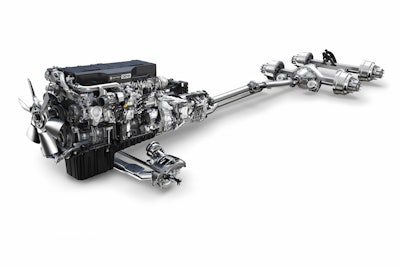 A driver recruiting and retention panel held at the CCJ Spring Symposium May 20 included CCJ Editor Jeff Crissey, Melton Truck Lines recruiting manager Melissa Stephan, Fremont Contract Carriers COO Tim McCormick and Epes Transport VP Kevin Rickansrud.
A driver recruiting and retention panel held at the CCJ Spring Symposium May 20 included CCJ Editor Jeff Crissey, Melton Truck Lines recruiting manager Melissa Stephan, Fremont Contract Carriers COO Tim McCormick and Epes Transport VP Kevin Rickansrud.Driver availability has been the top concern in the minds of fleet executives since 2009, but it now tops the charts by a wide margin. According to a Randall-Reilly MarketPulse survey in March, 67 percent of fleet respondents said it is their biggest challenge.
On Tuesday, May 20, a panel of fleet executives at the CCJ Spring Symposium in Franklin, Tenn., provided attendees with a wide-ranging discussion of strategies to find and keep drivers.
According to a recent survey, driver pay is now the fifth-most important thing on driver’s mind, noted the panel moderator, Jeff Crissey, editor of CCJ.
“We are in a different environment where I don’t think that driver pay is the end-all-be-all that it once was when it comes to onboarding and retaining the drivers,” he said. “There are a lot more things that fleets are doing now.”
The panel of fleet executives confirmed his hypothesis with data they have collected from their own drivers.
“When I recruit drivers, pay is no longer the number one issue. They want respect — that is what they always say,” said panelist Melissa Stephan, recruiting manager for Tulsa, Okla.-based Melton Truck Lines.
The panel stressed the importance of setting expectations with drivers at orientation and continuously gathering feedback on areas to change and improve to ensure expectations are being met.
Fremont Contract Carriers (FCC), a 330-truck fleet based in Freemont, Neb., follows up with drivers at the 10, 30 and 90-day mark following orientation to gather feedback.
“The idea here is to get them to talk about any issues they may have,” said Tim McCormick, the company’s chief operating officer. At FCC, the people who gather feedback are not directly involved with drivers. Someone from the customer service department may be the one making a call. This separation helps encourage drivers to engage in an open and honest discussion, he said.
FCC asks drivers about nine questions that cover different areas of its operations like driver managers, safety, maintenance and the fuel network.
Each department reviews the responses to see what may need to be addressed. Any changes that need to be made are immediately communicated to the driver, or drivers, who raised the issue.
Epes Transport System, an 1,100-truck carrier based in Greensboro, N.C., has key personnel spend time with drivers during the onboarding process to build relationships and discuss expectations, said Kevin Rickansrud, vice president of operations.
“We firmly believe you’ve got one time to make a first impression,” he said.
The panel discussed a number of other topics that included the impact of social media, electronic logging devices (ELDs), pay-for-performance, referral bonuses and health and wellness initiatives on driver retention.
For Melton Truck Lines, the most successful use of social media is as a support network for drivers’ spouses. It created a Facebook page called “the True Blue Alliance” for this purpose last January.
“It feels powerful,” Stephan said. “Every day people join the page and it grows and grows and grows.”
The panel said that implementing ELDs will initially create a spike in turnover, especially among independent contractors, but recruiting and retention numbers will rebound quickly now that the technology is widespread in the industry.
“We don’t see a big issue,” McCormick said.
The panel also agreed that driver scorecards and pay-for-performance programs have a positive effect on driver retention, but they must be simple and the goals fairly easy for drivers to attain.
FCC has a four-piece bonus program for company drivers that pays quarterly. The bonus is equally weighted for productivity, safe driving, out-of-route and fuel compliance, and on-time delivery (25 percent each).
“That seems to work out very well,” McCormick said. The company also offers non-monetary incentives. The most effective of these are going the extra mile to meet driver home time commitments and providing modern equipment with auxiliary power units.
Melton has increased its orientation pay for drivers and offers a monthly fuel bonus of up to four cents per mile extra for drivers that meet a minimum monthly productivity level. About 25 percent of its fleet is receiving the bonus every month. Drivers also get a pay increase starting at 120,000 miles, and drivers that return to Melton after leaving can keep their miles.
Melton uses predictive indexing to help driver managers understand the best way to communicate and train individual drivers to improve on performance for areas that its driver scorecard application identifies.
The company created a network of healthcare professionals for drivers to use, free of charge. This, combined with its many other health and wellness programs, earned the company the distinction of CCJ’s Innovator of the Year for 2014.
Of all the successful recruiting and retention strategies, the panel agreed that driver referrals are the most effective. Melton Truck Lines, Epes Transport and FCC reported that 20, 30 and 45 percent, respectively, of all new driver hires come from referrals.
Epes Transport pays its drivers a referral bonus that is split at the first dispatch of the new recruit and at 90 days. The company also has an incentive for driver managers that successfully bring drivers back.













